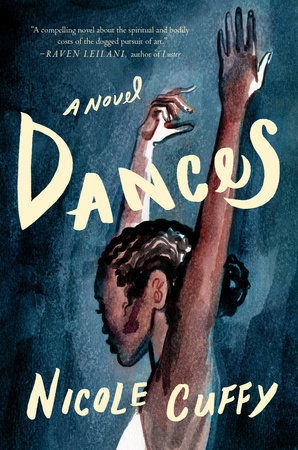
Dances
Nicole Cuffy
One World, 2023
Review by Jasmine Morris
Nicole Cuffy’s debut novel is a story brimming with vivid prose that weaves together threads of artistic ambition, black womanhood, and a complex internal journey. Cuffy charts how an uncomplicated dream becomes a complicated reality.
The novel focuses on Celine “Cece” Cordell, a twenty-two-year-old soloist at the New York City Ballet, as she rises to the height of her career. After a grueling climb to the spotlight, she is forced to make a choice that will test her resolve, not only in the realm of ballet but in every aspect of her life. The author’s background as a dancer steeps this novel in expertise and a love for ballet.
Cuffy infuses the novel with incredible lyricism and rhythm. Passages are filled with wonderful alliteration, like this description of Cece as a “brick-brown kid from Brooklyn.” Cuffy personifies Cece’s pointe shoes to demonstrate her need for control over everything. The shoes “yield” to her as she dances, seeming to bend the laws of reality so she can get closer to perfection. Cuffy crafts memorable and visceral imagery through simile. In one scene, a dancer’s torso is depicted as unnaturally malleable; “her torso was a limb too – it moved with as much grace, as much flexibility and fluidity as her arms.” These poetic moments add depth to the snappy prose and dialogue throughout the novel.
Cuffy’s masterful incorporation of literary devices pairs perfectly with the themes she touches upon. At the beginning of the novel, there is a dichotomy set up between Cece and the roles she plays. Her “reality is dual,” one where she is “Aurora, the white princess just turned sixteen who knows no suffering” and one where she is “Cece, the Black dancer of twenty-two, whose toes are screaming.” Cuffy takes this further, as even when Cece is not actively performing, she still struggles to reconcile the two halves of her world. She thinks, “What I can’t tell anyone, is that I so often feel as though I’m passing – not for a white woman but for a dancer.” Not only does this line allude to the imposter syndrome that sinks its teeth into Cece once she rises to Principal Dancer, but it also holds a deeper meaning considering Cece is Black. Cece’s mother’s earlier question to her young daughter will reverberate in the reader’s mind: “Trying to dance your way out of being Black?”
Cuffy meaningfully captures the complex nature of being Black and trying to achieve success existing as “the only Black face in a sea of white and tan.” There’s this unshakeable sense of isolation and hyper-visibility. She is constantly told that because she is Black she isn’t soft enough, not feminine enough. In a moment of tension between them, Cece reminds her mother that she told her “following your dreams is for white people.” One can’t help but feel like all of the discrimination Cece faces drives home this message.
Despite all the hardships Cece experiences as a Black dancer, there is happiness and beauty in her journey as well. Cuffy captures the seemingly psychic camaraderie that connects Cece and another Black dancer. She writes, “I saw only one other Black girl. She was tall and muscular, and her eyes kept flitting to me just as mine kept flitting to her, and we both saw each other looking, and I silently wished her merde,” the dancer equivalent of the theatrical slang, ‘break a leg.’
One instance of Cece learning to accept her Blackness instead of trying to blend in with the rest of the non-black corps comes when she gets a new hairstyle. Cece’s description of her braids was such a love letter to the style, one that evokes the senses and made me appreciate my own black and pink braids even more. Cece knows getting this hairstyle will make her stand out even more at her company and yet she thinks:
“I am now crowned with long braids that are black at the roots and fade to a tawny red by the time they reach the middle of my back. They are as firm as beads, and the parts in my hair allow air to lick at my scalp. . . [t]he braids are heavy and tight. But there is a part of me that likes the pain. It is like an invisible brand. Everything it sears is mine.”
Seeing Cece embrace an Afrocentric hairstyle as opposed to straightening her coily hair mirrors her changing attitude. Cece begins to develop into an artist willing to lose control; to take the risk of standing out rather than blending in. It is then that she begins to truly realize her ambitions of becoming an exceptional artist.
Dances is an exploration of the work of an artist, especially when that artist is a Black woman striving for success in a predominantly white field, and all the pain, heartbreak, bliss, and beauty it entails.
As a child, Jasmine Morris slept with a storybook like a teddy bear. She studied English, Professional Writing, and Publishing at UTM and Centennial College. She loves reading, gaming, and writing her characters into amusing situations. Her work is forthcoming or has appeared in Hungry Zine, OnTheDanforth.ca, and ROOM Magazine.